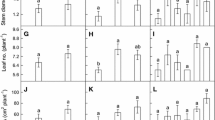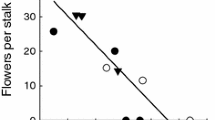Abstract
Along the west coast of the Antarctic Peninsula springtime ozone depletion events can lead to a two-fold increase in biologically effective UV-B radiation (UV-BBE) and summer air temperatures have risen ≈1.5°C during the past 50 years. We manipulated levels of UV radiation and temperature around Colobanthus quitensis (a cushion-forming plant, Caryophyllaceae) and Deschampsia antarctica (a tussock grass) along the Peninsula near Palmer Station for two field seasons. Ambient levels of UV were manipulated by placing filters that either transmitted UV (filter control), absorbed UV-B (reducing diurnal levels of UV-BBE by about 82%), or absorbed both UV-B and UV-A (reducing UV-BBE and UV-ABE by about 88 and 78%, respectively) on frames over naturally growing plants from November to March. Half the filters of each material completely surrounded the frames and raised diurnal and diel air temperatures around plants by an average of 2.3°C and 1.3°C, respectively. Reducing UV or warming had no effect on leaf concentrations of soluble UV-B absorbing compounds, UV-B absorbing surface waxes or chlorophylls. Warming had few effects on growth of either species over the first season. However, over the second field season warming improved growth of C. quitensis, leading to a 50% increase in leaf production (P < 0.10), a 26% increase in shoot production, and a 6% increase in foliar cover. In contrast, warming reduced growth of D. antarctica, leading to a 20% decline in leaf length, a 17% decline in leaf production (P < 0.10), and a 5% decline in foliar cover. Warming improved sexual reproduction in both species, primarily through faster development of reproductive structures and greater production of heavier seeds. Over the second field season, the percentage of reproductive structures that had reached the most developed (seed) stage in C. quitensis and D. antarctica was 20% and 15% higher, respectively, under warming. Capsules of C. quitensis produced 45% more seeds under warming and these seeds were 11% heavier. Growth of D. antarctica was improved when UV was reduced and these effects appeared to be cumulative over field seasons. Over the second season, tillers produced 55% more leaves and these leaves were 32% longer when UV-B was reduced. Tillers produced 137% more leaves that were 67% longer when both UV-B and UV-A were reduced. The effects of UV reduction were not as pronounced on C. quitensis, although over the second season cushions tended to be 17% larger and produce 21% more branches when UV-B was reduced, and tended to be 27% larger and produce 38% more branches when both UV-B and UV-A were reduced (P < 0.10). Few interactions were found between UV reduction and warming, although in the absence of warming, reducing UV led to slower development of reproductive structures in both species. The effects of warming and UV reduction were species specific and were often cumulative over the two field seasons, emphasizing the importance of long-term field manipulations in predicting the impacts of climate change.
Similar content being viewed by others
Author information
Authors and Affiliations
Additional information
Received: 4 August 1998 / Accepted: 1 December 1998
Rights and permissions
About this article
Cite this article
Day, T., Ruhland, C., Grobe, C. et al. Growth and reproduction of Antarctic vascular plants in response to warming and UV radiation reductions in the field. Oecologia 119, 24–35 (1999). https://doi.org/10.1007/s004420050757
Issue Date:
DOI: https://doi.org/10.1007/s004420050757




